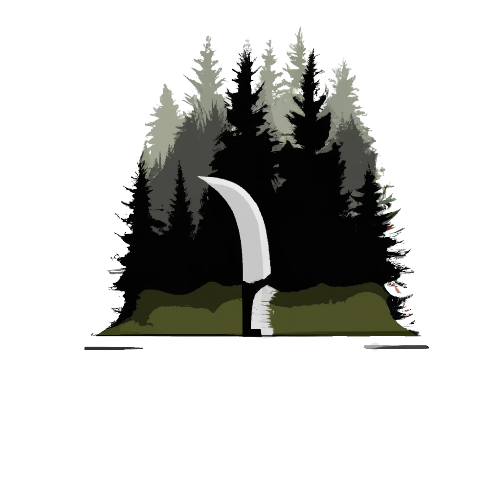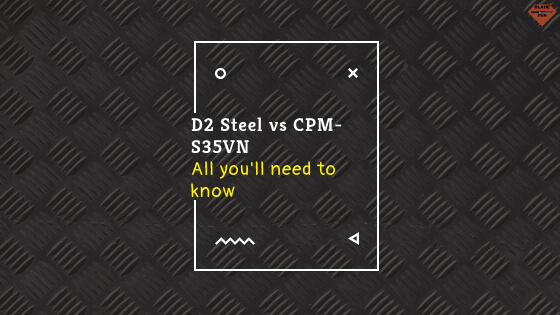D2 and S35VN (or CPM-S35VN–it’s the same thing) are both pretty good quality steels. But if you’re here, you’re probably wondering what the differences are and which one is better.
Well, here’s the short version:
CPM-S35VN is better than D2. It has more edge retention, corrosion resistance, ease of sharpening, and about the same toughness. The main difference between the two is that D2 rusts easier. If price isn’t an issue and you want high quality, go with S35VN. If you want something cheaper, go with D2.
That’s the short of it. Of course, there’s more we can go into. So… let’s do that.
What are the main differences?
The main difference you’re going to notice between the two is corrosion resistance: D2 will rust easier. Aside from that, S35VN will be easier to sharpen, but otherwise, you’re unlikely to notice much of a difference.
The reason for this is that D2 has less chromium than S35VN. D2 technically doesn’t have enough chromium to be considered a stainless steel–only a semi-stainless one. So, if you want to keep D2 from rusting, you’re going to have to dry it off as soon as it gets wet and keep the blade oiled.
S35VN, on the other hand, does have enough chromium to be considered stainless steel. So, if you don’t want to worry too much about having to wipe water off the blade, keep it oiled, or otherwise worry about humid conditions and it rusting, go with S35VN.
Another difference between the two is when it comes to chipping. D2 can get microchips and microcracks in the blade edge if you put too much pressure on it when sharpening it. This can lead to bigger chips and cracks in the blade when you put it through more strenuous activities. The solution here is to either get a different knife steel, or to not put much pressure on the blade when sharpening it.
S35VN doesn’t usually have these issues. Obviously, if you put too much pressure on any knife blade, it’s likely to get damaged, but that’s much less likely to happen with S35VN than with D2.
The reason is because some of the vanadium carbides with niobium carbides (compared to S30V, that is). That’s actually where the “N” in the name comes in. The “S” stands for “Stainless,” the “V” for “Vanadium,” and the “N” for “Niobium.”
The stainless denotes that it’s, well, stainless and won’t rust very easily. The vanadium is an element added to improve wear resistance and strength. The niobium does pretty much the same thing as vanadium, but it takes it to another level. It basically means that it won’t chip as much, especially compared to S30V.
One thing to note is that this can all differ based upon several factors, such as where the blade steel was made, who made it, how the heat treat went, what the edge geometry is, how the blade is maintained, and more. But if we were to compare the two steels in a vacuum, that’s what it would look like.
Which should you choose?
If price is an issue, go with D2. It’s going to have about the same toughness and edge retention, it just won’t be as rust resistant and will be slightly tougher to sharpen.
If price is an issue but you need something to be corrosion resistant, you’re either going to have to choose a different steel, or maintain your D2. This means you’re going to have to oil the blade often and wipe off any water that gets on it near immediately.
If price isn’t an issue and/or you need something corrosion resistant, go with the S35VN.
Recommended D2 Knives
If you’re interested in getting a D2 knife, here are some recommended knives with D2 blades.
Ontario Rat 1
The Ontario Rat 1 is a great knife that can withstand some punishment. The particular model linked comes in D2 steel. The others usually come with AUS-8 steel.
The Rat 1 comes with a liner lock, a plain, satin finish, drop point blade, and a thud stud opening. It’s a nice, simple knife that can withstand some punishment. If you’re looking for one of those, the Rat 1 is for you.
SOG Flash AT
The SOG Flash AT is a newer knife released in 2020, and I’ve got to say, it’s pretty cool.
It comes in 4 different colors: Civic cyan, urban grey, blackout, and garnet red. There’s also the option to get a partially serrated blade. The Flash AT has the XR-AT lock, assisted opening, a D2 blade (obviously), and a spine-mounted safety lock. It’s a pretty slick knife–and it looks like it.
If you’re interested in a fancier D2 knife, I think you’ll find the Flash AT to your liking.
CRKT Pilar II
The CRKT Pilar II is an all around solid knife. It’s got a modified sheepsfoot, a flipper, G10 handle scales, a frame lock, and D2 steel. While it doesn’t have the flashy features of other knives like assisted opening, it’s a nice, reliable, solid knife.
The main differences between this one and something like the Rat 1 are the blade and the handle. The Pilar II has a modified sheepsfoot blade as opposed to a drop point. It’s also got a different shaped handle and G10 scales instead of nylon.
It’s hard to go wrong with either of them. If you’re looking for a solid, reliable knife, you’ll either like the Pilar II or the Rat 1, depending on your preferences for blade (and handle) shape.
Recommended S35VN Knives
If you’re interested in getting a knife with S35VN steel, then here are some recommended knives with S35VN.
SOG Seal XR
The SOG Seal XR is another sweet knife by SOG. This one has an XR lock, a thumbhole, and a flipper that you can all use to open up the knife. It’s got a really smooth action that feels like assisted opening (but isn’t) and it can be opened up in reverse grip using your pinkie.
It’s got a clip point blade, S35VN steel, and a glass-reinforced nylon handle. If you’re looking for a slick knife that makes you feel like some kind of spec ops guy, this is for you.
Kizer Mini Sheepdog
Like the Ontario Rat 1, the Kizer Mini Sheepdog has a couple different variants. The one linked is the Ki3488A1, which has S35VN steel and a titanium handle.
The Kizer Mini Sheepdog has a cleaver blade, a frame lock, and a smooth, ball bearing pivot that makes opening it feel like it’s assisted. It’s the smaller version of the Kizer Sheepdog, coming in at an overall length of 5.77 inches. (The Kizer Sheepdog is 7.75 inches.)
Overall, if you’re looking for a smooth, cleaver-bladed knife, this one’s for you.
Pro-Tech Sprint
The Pro-Tech Sprint is an automatic knife. This means that you’ll need to check your local laws to make sure you can actually own this, but that pretty much goes with everything.
The Sprint has an S35VN blade and is a push-button auto. So, you press the button and the blade comes flying out. To close it, you hold the button and bring the blade back in. This one has a spear point, flat grind blade. It’s a nice little knife, coming in at 5 inches. If you’re looking for an auto, check this one out.

